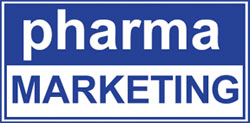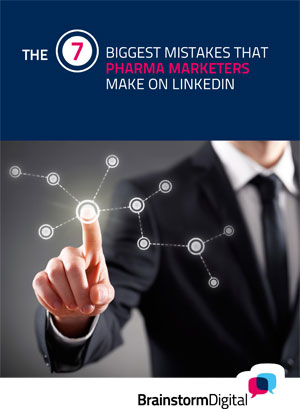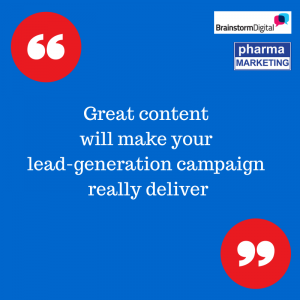We were really thrilled to have such a great turnout and enthusiastic feedback from the webinar we ran this week with the PharmaMKT LinkedIn group, “The 7 Biggest Mistakes Pharma Companies Make on LinkedIn… and How You Can Avoid Them Too.”
 During the session we packed a lot in, covering everything from how to use LinkedIn strategically to generate leads, to how to optimise your profile, what kind of content to share and how to use LinkedIn ads.
During the session we packed a lot in, covering everything from how to use LinkedIn strategically to generate leads, to how to optimise your profile, what kind of content to share and how to use LinkedIn ads.
Unfortunately time was tight and despite our best efforts, we didn’t manage to cover all the questions we received during the live event – so we’re going to cover them here instead!
Here goes, and if you have any more questions on how Pharma companies can use LinkedIn to grow their business, please email Lucy at lucia.muniz@gmail.com or Danny at danny@brainstorm-digital.co.uk
1. How long does it take to generate leads on LinkedIn?
With a proper lead-generation programme, you can see some results immediately. If you’re targeting the right people in the right way, some of your new contacts will be interested in your product or services right off the bat.
Most, though, need to be ‘warmed up’ and engaged before they are ready to take your call or meet you in person. For some people this happens after just a couple of points of contact with you, others can take several months until they want to buy.
The key is to continually build your network and have many prospects at different stages of the process, so that you are generating a steady stream of leads. On average, we expect to get 12 good leads for our clients every month, once the process has been underway for 3-4 months.
2. How long do you have to invest in LinkedIn lead-generation each day?
 Obviously, this depends how many leads you want / need to generate. Generally, we recommend that you spend, or someone spends on your behalf, 20-30 minutes a day building up your network and communicating with your existing contacts. So not long at all.
Obviously, this depends how many leads you want / need to generate. Generally, we recommend that you spend, or someone spends on your behalf, 20-30 minutes a day building up your network and communicating with your existing contacts. So not long at all.
What takes more time is developing terrific, helpful content to share with your contacts. This will probably be handled largely by your marketing / communications team (if that’s not you…), or an external agency.
Again, this is hard to estimate – some pieces of content take longer to develop than others and some companies may have more content to draw on than others – but these are what will make your lead-generation programme really deliver!
3. Do you recommend using Twitter at the same time, or are they completely separate?
If you’ve ascertained that your target audience is on Twitter as well as LinkedIn, using the two together will only make your LinkedIn lead-gen campaign more powerful. Ideally you’d use Twitter as another route to the companies and people you are trying to target, and another way to engage with them.
Using Twitter has additional benefits – done right, it can be a great platform for your content, raising your profile and reputation. And of course, it can be a powerful lead-generator in its own right (as can blogging, and virtually every other platform). But that’s another story!
What’s important is that you develop a comprehensive social media strategy at the beginning, so that you know exactly which platforms you need to be on and how you need to use them to generate leads and business.
4. You talked about the importance of planning your content – how far ahead do you go?
We find that you can develop quite a detailed plan 3-6 months ahead. Of course, there are some more timely elements you may have to develop at shorter notice, but you must know which big pieces of content you need written, which blog posts to assign and which seasonal events to plan for in plenty of time.
Further ahead than that, we recommend developing a skeleton schedule – a broad overview of the themes you might like to cover or any events that must be part of your schedule. This allows you to plan somewhat, while still maintaining flexibility (especially as social media platforms change their rules so often – more about that here.)
5. You recommended sparking conversations with your prospects by asking them questions about the issues that concern them. How do I ask questions that are not specific to my expertise and are still relevant?
 Sadly on this one there are no shortcuts – if you are targeting a particular group of prospective clients, you need to get to know them really well beforehand. That is the only way to develop content that will really ‘speak to them’ – which is the type of content that will allow you to build up a relationship with them.
Sadly on this one there are no shortcuts – if you are targeting a particular group of prospective clients, you need to get to know them really well beforehand. That is the only way to develop content that will really ‘speak to them’ – which is the type of content that will allow you to build up a relationship with them.
As in all marketing, you need to ‘Know Your Audience’!
How do you do that? The best way is to develop Buyer Personas – essentially a really detailed archetype of your target clients, which can be used to understand what kind of issues they’re interested in and – most importantly – what will make them buy from you.
The process can involve market research, detailed interviews with clients and with your team as well, depending on needs and budget, and is by far the most useful way of generating and presenting this information.
Should your budget not stretch that far (the most basic buyer personas will cost around £2,500), here are some other ways to develop an understanding of your target clients:
- Talk to existing clients who fit into the group you’re trying to target
- Talk to your sales team, who should have a decent understanding of their needs and concerns
- Use social media to monitor the discussions being conducted by your target group
- Use LinkedIn groups to monitor the discussions being conducted by your prospects
- Check out any market research, surveys, demographic info etc. conducted by your company into their client base
Getting this right is the basis of your success as a marketer.
6. How do you develop great content if you are a small company rather than a large Pharma company?
Great question, because resourcing is often the number one problem in social media programmes, across all industries.
 The first rule is not to take on too much. If you don’t feel that you can handle a daily blog post, don’t set that as a target. Right from the beginning, make your goals realistic – because otherwise you’ll give up in frustration.
The first rule is not to take on too much. If you don’t feel that you can handle a daily blog post, don’t set that as a target. Right from the beginning, make your goals realistic – because otherwise you’ll give up in frustration.
Conduct an audit of any content you have already, that can be updated or re-purposed. Most companies are surprised to discover how many old brochures, essays, booklets, surveys and so on they have that can actually be re-written in an interesting way or used again in a different format, saving them a ton of work.
Every major piece of content you develop should, in fact, be re-purposed, so that one piece of work can deliver several things for you to share. Did you write a terrific blog post? How about filming a two-minute video summarising the main points, or turning it into an infographic? If your marketing department has just produced a great eBook, turn it into a series of blog posts or tips that you can tweet every day over several weeks.
Remember that not all content has to be original – in fact, it’s fine if a majority of the posts you make on social media are not your own material, as long as it’s relevant to your target audience. One post in six should lead back to your own website, and of course you want to develop your own major pieces of content to share with your target clients as well.
Last but not least, spread the effort. If you can’t afford to outsource your entire programme, perhaps you can outsource some of it (is generating blog posts a particular problem? Pay someone else to do just that bit, while you handle your social media accounts yourself). And involve your staff members – with rewards, not threats.
Any more questions on how to use LinkedIn to generate leads? Please feel free to email Lucy at lucia.muniz@gmail.com or Danny at danny@brainstorm-digital.co.uk






1 Comment. Leave new
Hi,
Social media plays an important role in lead generation as well as in SEO also. For online promotion site optimisation is necessary and the necessity for websites.
Thanks
http://www.leadmaster.in